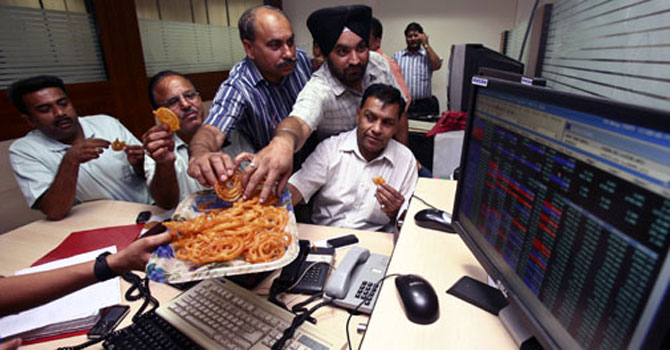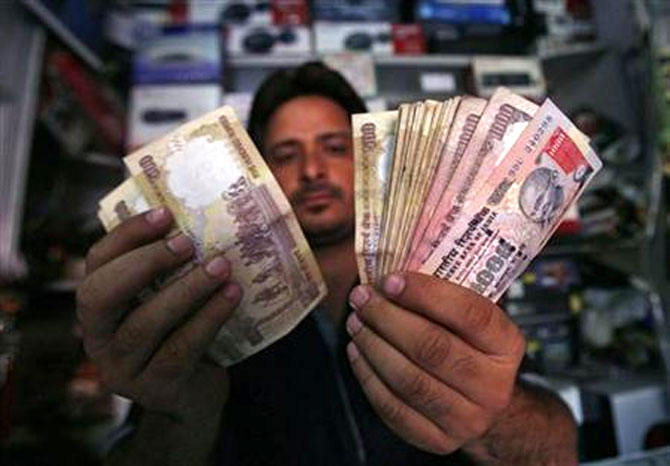 | « Back to article | Print this article |
What is Sensex riding on: Modi or cheap foreign funds?
ECB cuts rates to negative, Libor down to its lowest in 30 years
This year is turning to be one of the best for Indian equity investors. The benchmark S&P BSE Sensex is up by a fifth since the year began and expected to go even higher. Bulls on Dalal Street are now talking of a new rally, triggered by a growth-oriented government at the Centre under Narendra Modi.
The Centre is expected to quicken the pace of growth of gross domestic product (GDP) and corporate earnings, supporting the higher stock valuations. At Friday’s close, the Sensex is trading at nearly 19 times the underlying combined earnings of its 30 constituent companies in the past 12 months.
“We expect the growth in industrial production to accelerate to 10-12 per cent in three years from flat to negative currently. To that extent, current valuations are justified,” said Sankaran Naren, chief investment officer, ICICI Prudential Mutual Fund.
Click on NEXT for more...
What is Sensex riding on: Modi or cheap foreign funds?
Meantime, global capital is getting cheaper. The London interbank offered rate or Libor has fallen to its lowest in 30 years as central banks in the US, the European Union (EU), the UK and Japan stick to low policy rates to revive growth.
A top-rated bank can raise one-year dollar loan at 0.53 per cent in London, one of the world’s largest financial centres. Such cheap capital means even Indian companies with a return on equity in the single digits are a value buy for foreign investors (see chart).
The Sensex companies offer 15.2 per cent return on equity on average, while their dividend yield is 1.4 per cent on a portfolio that mirrors these 30 firms. This is much higher than what capital costs in London. The only risk is from a weak rupee. Luckily, the Indian currency has been rising for nine months now.

Click on NEXT for more...
What is Sensex riding on: Modi or cheap foreign funds?
India is part of a wider global rush for high-yielding emerging market assets. In the year to date, the Indonesian market is up 15.5 per cent, the Turkish, 18.6 per cent, the South African, 8.3 per cent, and the Brazilian, 3.1 per cent.
The outliers are the Russian and Chinese markets that fell 1.3 per cent and 4.1 per cent, respectively; the latter declined despite the country’s economy growing more than peers.
Dhananjay Sinha, institutional equity head at Emkay Global Financial Services, said, “At its current valuation, the market has factored in GDP growth of eight-nine per cent next year and industrial growth of 10-11 per cent a year against industrial growth of one per cent in the past 18 months, the longest stretch of low growth in nearly two decades.”
Given that adjusted for GDP growth, the Sensex is the most expensive since the dotcom bubble in 2000, the bulls will need sharp gains in the rate of rise of GDP and corporate earnings in 12 months. The index is valued at 4.1 times GDP growth in the past financial year against the median GDP-earnings multiple of 2.4 (since 1997) and 5.3 times the growth rate at the height of the dotcom bubble. The current GDP-earnings multiple is higher even than at its peak during the growth boom in 2003-08.
“In 2008, GDP growth was at eight-nine per cent, while the Sensex was trading at around 20 times on-year forward earnings. Now, the GDP is growing at 4.5 to five per cent, while the Sensex is already trading at a P/E (price-earning multiple) of 16,” Sinha said (see chart).
Click on NEXT for more...
What is Sensex riding on: Modi or cheap foreign funds?
From late 2003 to the middle of 2008, GDP grew at an average annualised rate of 8.7 per cent and corporate earnings at a compound annual growth rate of 40 per cent. In contrast, GDP at constant prices grew 4.8 per cent in 2013-14 even as corporate profits rose 8.2 per cent.
Low growth and high historical valuation makes liquidity the most important factor for the equity market. Global liquidity depends on economic conditions in developed markets. Monetary tightening there will hit emerging markets. However, that seems unlikely. Earlier this week, EU’s European Central Bank (ECB) cut interest rates to negative on funds parked with it.
Not everyone, though, agrees that it’s not economic fundamentals behind the rally. S Krishna Kumar, equity head at Sundaram Mutual Fund, said, “Markets always run six-12 months ahead of time. People have already started to discount 2015-16 growth, the first full-year term for the government. While ECB is pushing for higher stimulus, the US’ Federal Reserve is withdrawing its stimulus. Since markets are confident about growth, liquidity will continue to flow in.”




